Join the tribe of Movement & Calisthenics Athletes – people just like you that are working with their own body weight to get strength, lose fat build muscle, recover from injuries and live their best lives
Do you want to learn how to combine The Movement Athlete app program with weightlifting?😲 Look no further; we have all the answers you need to get the best of both worlds for your training!
Combining weightlifting and calisthenics is a great way to maximize your strength and fitness gains.💪 Both weightlifting and calisthenics offer unique benefits, and combining them allows you to target different muscle groups and increase your overall fitness level. Weightlifting involves lifting heavy weights to build muscle mass and strength, while calisthenics involves using your own body weight to perform exercises that improve your strength, flexibility, and endurance.
The Movement Athlete calisthenics app is powerful for improving strength, mobility, and overall fitness through PERSONALIZED and ADAPTIVE bodyweight workouts. One of the app’s unique features is customizing workouts to easily implement weights into your training.
There’s no need to separate weightlifting and calisthenics.🤛
By incorporating both weightlifting and calisthenics (through the best calisthenics app ever!) into your fitness routine, you can achieve a well-rounded, balanced workout that will help you reach your fitness goals more efficiently.
In this article, we will explore the benefits of combining weightlifting and calisthenics and provide tips on incorporating both types of exercise into your routine from The Movement Athlete app.
🏆 🔥Benefits of combining weightlifting with calisthenics
Why would you like to combine them? Because you don’t want to miss out on these amazing benefits, the combination can offer!
- 🏆 Unlimited strength potential – We can continue building absolute strength because we’re working with weights. If you opt for weighted calisthenics, you can improve your absolute and relative strength at the same time!
- 🏆Straightforward progression – Increasing intensity is now made easy. You just have to add more weight to your weighted exercise, similar to weightlifting.
- 🏆 Removes limitation of calisthenics exercise intensity – Combining two approaches eliminates the limitation of bodyweight intensity. You can keep your intensity high and volume low for maximum strength development. For example, when you have mastered one-arm push-ups, it’s difficult to progress even further with the strength aspect if you don’t have weights.
- 🏆 Translates to strength-based calisthenics skills – General strength from weightlifting can help build a stronger foundation of strength for skills such as planche, levers, human flag, etc.
- 🏆 Combines your favorite movements – If you love bench presses and you love pull-ups, you don’t have to segregate them anymore. You can combine them into your workout program!
- 🏆 Highly effective muscle-building approach – We’re now combining the power of compound movements from calisthenics and isolation exercises from weightlifting. This allows helps improve muscle gains, especially for more experienced athletes.
- 🏆 Badass – Let’s face it. Sometimes we need that ego boost to get more motivation and discipline. And there’s nothing more badass than doing dips with huge weight plates strapped unto your belt!
🎯Goals of combining weightlifting and calisthenics
The ultimate reason for combining these two approaches is to build strength and muscle. That’s it. Each approach has its advantages and disadvantages, but combining the two nullifies the disadvantages so you can get the most from them.
Here are the pros and cons of each approach:
| 👍PROs | 👎CONs | |
| Calisthenics |
|
|
| Weights |
|
|
🧐Who should combine weightlifting and calisthenics?
For those who are looking to increase their strength and muscle, look no further than combining these two amazing approaches. Combining weightlifting and calisthenics will help you achieve the best of both worlds, as seen in the benefits above.
It’s best first to master at least the calisthenics fundamentals, such as the ones below, before attempting to combine approaches.
- 👊 Push-ups
- 👊 Dips
- 👊 Pull-ups
- 👊 Bodyweight Rows
- 👊 Squats
- 👊 Wall handstand
- 👊 Core work
Mastery of the exercises above will help you effectively and safely transition into the hybrid training/weighted calisthenics training.
😱Who shouldn’t combine weightlifting and calisthenics?
Beginners can actually combine weightlifting and calisthenics right out of the bat. They can opt for a hybrid calisthenics training approach since these are more manageable and scalable to their level. However, it can be too complicated for beginners to set up. Training intensities and volume can also be too difficult to manage, resulting in overtraining or injuries.
🔥We highly recommend beginners start with either weightlifting or calisthenics, depending on preference.
Beginners are highly advised to avoid weighted calisthenics as this approach requires mastery of the calisthenics fundamentals.
If you need help with your fundamentals, then check out The Movement Athlete app by starting with the assessment below for Free!
✨Progressive Overload with weightlifting and calisthenics
We know that progressive overload is the game’s name if you want to make progress. When combining weights with calisthenics, the protocol aims to increase your rep ranges and set them before adding weights gradually.
For example, if you have mastered the dips, then you can add a 2.5kg weight plate to your dips. This will lower the number of reps you can do with dips, and that’s a good sign. This means the exercise is heavier. Then, increase your number of reps until you get comfortable with a certain rep range (around 10-12 reps). Then add more weight (add another 2.5kg to make a total of 5kg) to your dips and so forth.
Building strength is gradual, so don’t rush this unless you want to get injured. The heavier you push, the slower the noticeable increase of strength you will gain.
💥OPTION 1: WEIGHTED CALISTHENICS
What is weighted calisthenics🤔
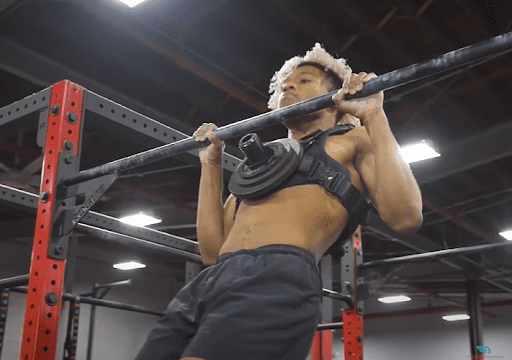
This approach uses the basic movement patterns of calisthenics but with added weight to increase intensity. Weighted calisthenics lets you enjoy your favorite bodyweight exercises but removes the intensity limitation since you can easily add more weight to the exercise.
The common exercises you would want to add weight into are literally the fundamental movement patterns: basic push-ups, dips, pull-ups or chin-ups, bodyweight rows, and squats. You can add weights to these exercises using a dip belt and weight plates, dumbbells, or kettlebells, or you can also use a weighted vest such as this one: EZ Weight-plate-loaded vest.
Watch this video for a review: 📍Kensui EZ WEIGHTED VEST REVIEW Is This The Best Weighted Vest
👍Advantages of Weighted Calisthenics
For those who enjoy performing the basic movement patterns but need an additional challenge, then this one is for you. You will unlock limitless strength and muscular gains using bodyweight exercises and weights.
The general strength you gain from this approach is also transferable to specific calisthenics skills. For example, weighted push-ups and dips can help you unlock more pushing strength for planchet. Weighted pull-ups can help you progress much faster in one-arm pull-ups/chin-ups.
👎Weakness of Weighted Calisthenics
😢Fewer exercise options
Movement patterns can get repetitive since you will do the same exercises but with added weights. It’s the same case in weightlifting, but with weighted calisthenics, you’re going to be limited to the major movement patterns, so there are a bit fewer options.
Solution: Use advanced calisthenics variations with weights
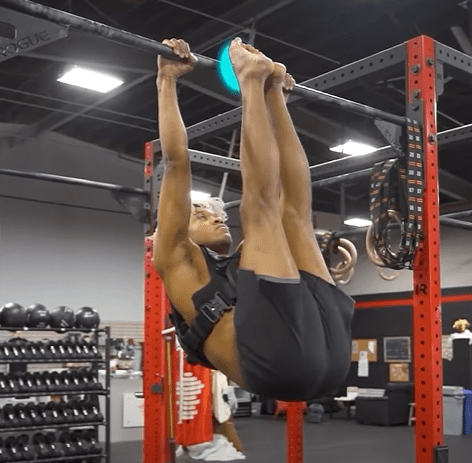
However, if you’re advanced enough, you can also use much more complex calisthenics progressions with weights. For example, you can do weighted archer push-ups on rings or weighted wall handstand push-ups. Of course, the risk of injury increases because skill and strength requirement increases, so proceed gradually with these weighted versions.
Who Should Do Weighted🏋️♂️ Calisthenics
If you’re already hitting the endurance-orientated rep range (15 reps or more) with your calisthenics fundamentals, then it’s time to move to weighted calisthenics to maintain strength progress. Weighted calisthenics is an excellent option for those who have mastered the basics of bodyweight training but want another path to progress rather than pursuing more challenging full-bodyweight variations. Instead of building more strength towards one-arm or one-arm pull-ups, weighted push-ups and weighted pull-ups are excellent options to develop strength and muscle further.
If you’re interested in learning more advanced skills, weighted calisthenics is also perfect for building general strength that further translates to specific calisthenics strength-based skills. For example, working on weighted push-ups improves your general pushing strength in the horizontal plane. This benefit transfers to better pushing capacity for planche. Weighted pull-ups also serve a purpose for one-arm pulling exercises.
Just take note that specific skill training is still the priority if you want to learn a strength skill. No matter how strong you get in weighted push-ups, if you don’t train your planche directly, progress will be slow (or nearly non-existent) toward the skill.
🧐How to Implement Weighted Calisthenics
It’s as straightforward as following your regular training program. But instead of focusing on body weight alone, you will incorporate weights into certain key exercises, such as the main four for the upper body: dips, push-ups, horizontal pulls, and pull-ups/chin-ups. This way, you can balance the strength development for horizontal and vertical pushing and pulling motions. Squats also can be weighted.
For other movement patterns, such as handstands and core work, you can opt for the basic bodyweight variations, as these should be enough for now since you will be taxing your body too much with the weighted variations.
🏋️♂️Weighted Calisthenics Training Example
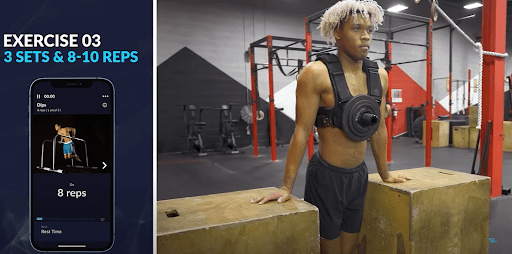
We plan to integrate a weighted calisthenics option in The Movement Athlete app. You can now opt for the calisthenics fundamentals and add weights to the exercise. Gradually add weight.
Don’t jump into a 10kg pull-up even after mastering the regular pull-up for 15 reps. Start with the lightest weights as much as possible to begin your journey. Usually, plates start with 2.5kg. That would be sufficient enough to spike up the intensity of the exercise and drop your capacity to do more reps.
Your workout with the TMA app will look like the table below. But instead of opting for the fundamental or a more advanced variation, opt for adding weights to the exercises.
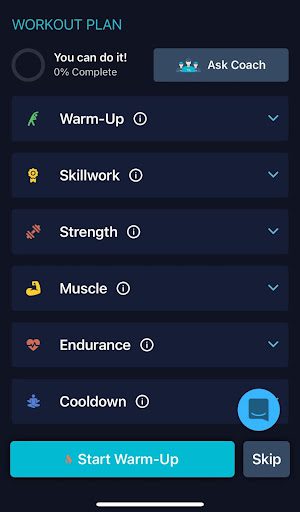
Take note: with the weighted variations, you would need to take more extended rest periods due to the high intensity of the exercises. It might feel boring to wait longer, but giving your body time to recover within your sets to execute weighted exercises and maximize your gains safely is crucial.
⚡️Full Body Training
This is the full body training variation targeting all muscle groups. You will need to train this three times per week. Leave a day of rest in between each session.
Follow the regular warm-up from the app.
You can add 10 reps of push-ups and 10 reps of wide pulls since they should be relatively easy for you now.
| Exercise | Sets & Reps | Rest Period |
| Planche Progression | 3 sets of 6 – 10 seconds | 3 minutes |
| Bench Press | 3 sets of 8 – 12 reps | 3 minutes |
| Banded Planche Progression | 3 sets of 10 – 15 seconds | 2 minutes |
| Pseudo Planche Lean | 3 sets of 15 – 20 seconds | 2 minutes |
| Shoulder Press | 3 sets of 8 – 12 reps | 2 minutes |
| Straight-Arm Dumbbell Anterior Raises | 3 sets of 10 – 15 reps | 1:30 minutes |
| Box Extension Progression | 3 sets of 8 – 12 reps | 1:30 minutes |
After performing the exercise above, proceed with your other bodyweight exercises targeting your core, lighter skills, and mobility.
Or, if you’re advanced enough, you can continue performing the whole set of exercises with weights similar to our example using the Kensui EZ Weighted Vest.
Video’s here: 📍Do THIS Weighted Calisthenics Workout (Push, Pull, Legs & Core) for a FullBody Blast & Maximum Gains
You can also use the app for more mobility work during your rest days, but we recommend going light with it. Cardio-based training with the TMA app can also work during your off days.
✊Split Training
Upper-Lower
Alternatively, you can also opt only for the upper body and core exercises for a single session. Then another session for your lower body. This upper-lower split is an amazing option to reduce your training time while still getting the most from your weighted calisthenics sessions. The drawback is that you must increase your training frequency from 3 to 4 sessions, which isn’t that bad!
You must choose your program’s “muscle group” option to do this in the app. Opt for the general tab and choose the upper body for your first day.
Then the same thing follows. Perform the fundamentals but with weights. Continue performing the other exercises as a bodyweight variation to supplement your weight training.
Take the rest day for your upper body the next day or choose the lower body instead and proceed to add weights for your squats.
✊Push-Pull Split
Another option is the push-pull split. This workout divides your training days based on the movement pattern you need to do.
This approach follows the same format of adding weights to the calisthenics movements. Still, the exercises are separated per day, similar to the schedule below, which you can follow:
Mon – Push
Tue – Legs
Wed – Pull
Thur- Rest
Fri – Push
Sat – Pull
Sun – Rest/Legs
For push days, you’re going to choose the per muscle group workout in the app. Choose the specific tab and choose these muscle groups:
Pushing muscles
- Chest
- Deltoids
- Shoulders
- Triceps
For the pull days, you’ll follow the same steps but choose these muscle groups instead:
Pulling muscles
- Back
- Biceps
- Forearms
- Lats
- Traps
The same goes for your legs:
Leg muscles
- Glutes
- Hamstrings
- Inner thighs
- Quads
- Calves
For your core work, you can choose to split them or combine them together. Choose one or two days to add to your pushing, pulling, or leg day at the end of your session.
But most of the time, we recommend doing it on your rest day OR during your leg day since the hip flexors and lower back are mainly used during your lower body and core training.
💥OPTION 2: HYBRID CALISTHENICS
What is Hybrid Training🤔
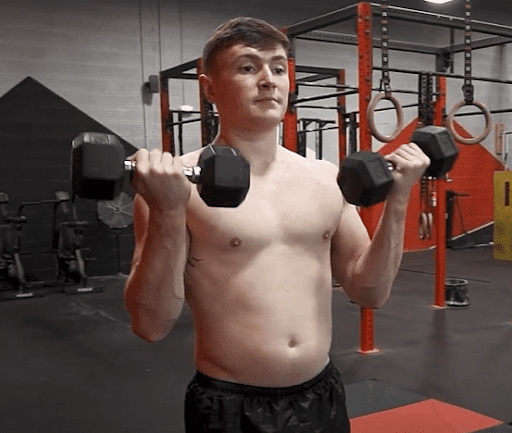
Hybrid training is said to be the future. It’s a mix of calisthenics and weightlifting into one to get the best of both worlds in each and every workout.
You can say that Hybrid is the superset of weighted calisthenics because you can still incorporate your weighted calisthenics exercises into your routine. The bigger advantage is that you can also add other weight-lifting exercises perfect for isolating muscles and building superior hypertrophy gains. It’s breaking the boundaries of weightlifting and calisthenics and combining them together for the ultimate resistance training approach.
👍Advantages of Hybrid Training
As we mentioned, you get the best of both worlds. You can enjoy your favorite calisthenics movement patterns and the benefits of their compound nature. Through weightlifting exercises, you can also experience the advantages of direct isolation work for optimal hypertrophy gains. You can also interchange some movement patterns from calisthenics to weightlifting and vice versa.
👎Weakness of Hybrid Training
The main weakness of this approach is the equipment required. You will need equipment for both calisthenics and weightlifting. It’s not so extensive, but it can be if you want to get the best exercises that elicit the most muscle activation for each body part.
That being said, it’s also not ideal for beginners or those who have just recently mastered their fundamentals. Hybrid training requires a high amount of training capacity.
🤔Who Should Do Hybrid Training
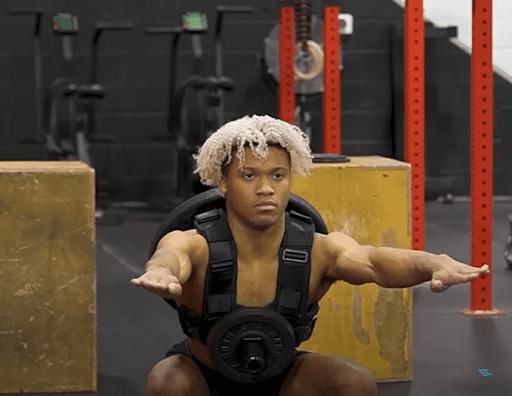
This approach is meant for those who already have mastered the calisthenics fundamentals and looking to improve their muscle and maximum strength using a combination of weight lifting exercises and weighted calisthenics.
The obvious requirement for this is gym equipment. You should have access to a gym or at least have a home gym with most of the equipment required for the exercises.
🧐How to Implement Hybrid Training
Since we’ve already tackled the weighted calisthenics, you will already know how to implement this workout strategy.
Hybrid can also be done with either a full body approach or a split workout similar to the weighted calisthenics. The major difference is the exercise selections. So here, you would need more knowledge of which exercise you can opt for or switch. You can even add more exercises on top of what the app has provided you.
Hybrid training offers flexibility in exercise selection, but this doesn’t mean you can switch up all exercises every session. You need to have a solid, clear structure that you are going to use to ensure progress.
🥇Choosing the Exercises for Hybrid
For example, you can work out your shoulders either with pike push-ups or dumbbell shoulder presses. You can stick to either exercise in your program or commit to a specific alternate per session if you have two sessions per week that target your shoulders.
Do not randomly perform opt for each exercise too randomly, as this will lead to slow progress. Keep your intentions clear when deciding on which exercise or protocols to use.
So the strategy here is to follow the TMA app but substitute or add different exercises, ensure you follow the same protocols, and add progressive overload by adding more reps before adding weight.
You can see that the Hybrid training might be complex because there are many exercises to choose from, but it’s quite simple to incorporate with the TMA app.
Follow the program provided but substitute the bodyweight exercises in the app with the options provided below.
Then you can add additional exercises for each body part at the later phase of the workout. Again, focus on substituting the main movement patterns:
- ✔️ Dips
- ✔️ Push-ups
- ✔️ Shoulder exercise (handstand or pike push-ups)
- ✔️ Pull-ups
- ✔️ Inverted row (wide/close pulls)
Dips
Weighted dips
Ring dips
Push-ups
Bench press
Weighted push-ups
Ring archer push-ups
Additional chest exercises you can add
Dumbbell Chest flyers
Gymnastic rings chest flyers
Cable crossover
Incline bench press/dumbbells
Shoulder exercises
Pike push-ups/Handstand push-up variation
Shoulder press dumbbell/barbel
Arnold press
Dumbbell side lateral raises
Pull-ups (alternate each grip each training session or use the one that’s comfortable for your joints)
Weighted pull-ups/chin-ups
Lat pull down
Mantle chin-ups
Archer pull-ups
Lat-focused seated cable row
Deadlift
Inverted row
Weighted rows
Dumbbell rows
Barbell rows
Bent over row
Seated Cable row
Additional back exercises:
Dumbbell Pullover
Dumbbell Rear delt flyers
Ring delt flyers
Deadlift
Accessory exercises are done during the latter part of training
Since the major muscle groups tend to get fatigued earlier than the arms, you can add 1 or 2 exercises in the list below at the end of your workout for more gains.
Keep the intensity light to moderate and the reps high!
3-5 sets of 10 – 25 reps
Biceps
Bodyweight bicep curls
Dumbbell curls
Dumbbell hammer curls
Preacher curls
Ring pelican curls
Triceps
Tricep push-ups
Tricep dip
Tricep extensions
Dumbbell tricep kick-back
Weighted🏋️♂️ Hybrid Training Example
Follow the same protocol for the weighted calisthenics. Choose if you’re going full-body or split. You can also incorporate some lighter skills, such as L-sits and handstands, into your training.
Here’s an example of how a full-body workout might look when using the TMA app in conjunction with weights.
| Exercise from TMA | Exercise for Hybrid | Sets & Reps | Rest Periods |
| Dips | Weighted Dips | 3 – 4 x 6 – 8 reps | 3 minutes |
| Pull-ups | Deadlift | 3 – 4 x 6 – 8 reps | 3 minutes |
| Push-ups | Bench Press | 3 x 8 – 12 reps | 2 minutes |
| Inverted rows | Bentover Row | 3 x 8 – 12 reps | 2 minutes |
| Handstand | Weighted handstand or dumbbell shoulder press | 3 – 5 x 30 – 60 secs | 2 minutes |
| Squats | Barbell Back Squats | 3 – 5 x 8 – 15 reps | 3 minutes |
| Dumbbell lateral flyes | 3 – 4 x 10 – 20 reps | 1 minute | |
| Dumbbell curls | 3 – 4 x 10 – 20 reps | 1 minute | |
| Tricep push-ups | 3 – 4 x 10 – 20 reps | 1 minute |
The last three exercises are additional moves you can add to your TMA workout. Then you can proceed with other exercises from the app, such as core work and cool-down exercises.
💥OPTION 3: Two Different Training Cycles
The other option you can do is to fully separate your calisthenics training and weightlifting training into different cycles. Training cycles can last between 4 to 12 weeks, depending on your program.
With this approach, you still get the best of both worlds since you don’t necessarily lose the gains in each training cycle. Each cycle can even supplement one another for maximum potential.
👍Advantages of Separating Training Cycles
This method can boost your progress in calisthenics while minimizing the risk of injuries and overtraining. For example, if you want to train for planche. You can start of with a strength training weightlifting cycle for three months. Build as much general pushing strength as possible. This can carry over to your planche training.
👎Weakness of Separating Training Cycles
Separating calisthenics and weightlifting into cycles requires careful planning. Your main goal should be aligned. For example, if you want to learn planche, your weight lifting training should not focus too much on hypertrophy because this will make you too heavy.
You can solve this issue by creating a solid plan for the whole training cycle.
🧐How to Implement Separate Training Cycles
You can do this by planning and scheduling around a year of your training. Preparing around 3-6 months for each approach is ideal, but it still depends on your goal, as seen in our training cycle example below.
🎯Separate Training Cycle Example
For this example, we’re going to use weightlifting to create a general base of strength and muscle, then focus on planche training for the succeeding training cycle.
So we will start with a strength-based training cycle for three months focusing on general push-pushing-leg strength. The focus here is to build as much absolute strength as possible.
After the three months training period, we can shift into a more specific planche training. This training cycle can last a full year or more until we reach the goal of at least a 10-second straddle planche. Once you have mastered the planche, we can move to another training approach and train the planche 1-2 times per week for skill maintenance.
🤔Frequently Asked Questions
🔎How can I combine weightlifting with skill training?
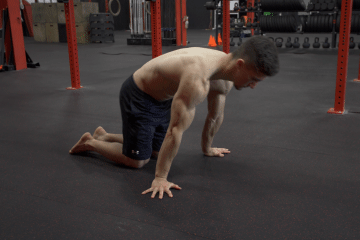
Combining these two can be tricky because the risk of overtraining can be apparent. In addition, calisthenics strength skills require specific training, such as working with the progressions and using the supplementary exercises needed for the skill. However, this doesn’t mean it’s not possible.
For example, when training for planche, you can follow the regular planche routine and incorporate SOME exercises that offer transferability to the planche, such as improving pushing strength and isolating muscle groups. Here’s an example of how your planche workout might look like while following the TMA app.
| Exercise | Sets & Reps | Rest Period |
| Planche Progression | 3 sets of 6 – 10 seconds | 3 minutes |
| Bench Press | 3 sets of 8 – 12 reps | 3 minutes |
| Banded Planche Progression | 3 sets of 10 – 15 seconds | 2 minutes |
| Pseudo Planche Lean | 3 sets of 15 – 20 seconds | 2 minutes |
| Shoulder Press | 3 sets of 8 – 12 reps | 2 minutes |
| Straight-Arm Dumbbell Anterior Raises | 3 sets of 10 – 15 reps | 1:30 minutes |
| Box Extension Progression | 3 sets of 8 – 12 reps | 1:30 minutes |
During the weighted exercises, you can pause the TMA app workout as you’re working briefly. Continue with the app after the weighted exercises have been completed.
🔎Can I combine skill training with weightlifting and calisthenics?
This depends on the context. If you’re the main goal is to learn planche, for example, then combining certain weightlifting elements can help. However, if you’re planning to “master” planche while performing strength and muscle-building protocols with weightlifting and calisthenics, then expect slower progress.
The main idea is to focus on one major upper-body goal at a time. The law of specificity should be acknowledged if you want to see more progress in a safe manner while avoiding injuries and frustrations.
🔎How do you combine calisthenics with other disciplines?
This question is quite similar to the previous one. It’s basically knowing what you want. For example, if you want to go cycling or do martial arts while combining calisthenics and weightlifting, you must schedule your routine well. But don’t expect you to progress faster than focusing on one training approach at a time.
For this, we recommend performing a periodized training cycle. Prepare at least three months of weightlifting and calisthenics while focusing on strength and muscular gains. After those months, you can focus on your chosen discipline. It’s quite similar to how professional athletes structure their training. They do strength and conditioning during the off-season, then focus on their sport when the start of the season comes closer.
🔎How do I add cardio to my training?
Of course, you can, and it’s highly recommended! However, you have to stay smart with how you do it. Doing too much cardio, such as implementing frequent HIIT training, can impede your muscle recovery. This leads to fewer gains.
In addition, adding excessive cardio before your workout can affect your main workout and can also lead to less progress.
We recommend adding at least walking 6 hours apart from your main workout. If it can’t be done, reserve your low-impact cardio after your main workout or do your high-intensity cardio during your off days.
🔎How long should my workout last when combining weightlifting and calisthenics?
Workout duration should still last around 1 hour to 1 and a half. Maybe 2 hours max if you have an extensive cooldown period. But in general, instead of focusing on the duration, you want to focus on the quality of your workout.
The combination of weightlifting and calisthenics prioritizes strength and muscular gains. This type of workout doesn’t usually last longer than two hours. Reserve those for lower-intensity skill training.
As a brief guide, if you think you’re doing too much, then you’re probably doing too much. You’ll immediately know if a workout is not challenging for you.
Read more here: 📍How Long Should I Workout: The Truth Will Shock You!
🔎Which Approach Should You Choose?
As we’ve mentioned almost in every section, this will depend on your goals and how you want to achieve them. There’s no black-and-white answer, and you can try out an approach for a week before committing to it.
What matters most is you stay consistent, train progressively gradually, and work through even the hard times.
📌TAKEAWAY
In conclusion, combining weightlifting and calisthenics can be a highly effective way to achieve a balanced and functional physique. By incorporating both types of exercises into your workout routine, you can reap the benefits of increased strength, muscle mass, and overall fitness.
While each type of exercise has unique advantages, combining them allows you to optimize your training and achieve your fitness goals more efficiently. Remember to start slow and gradually increase the intensity, prioritize proper form and technique, and listen to your body to avoid injury. With dedication and consistency, the combination of weightlifting and calisthenics can help you build a strong, healthy, and functional body.
Combining weightlifting with the best calisthenics app in the market offers the best of both worlds. There’s no need to separate the two training styles. The black-and-white thinking is over. Calisthenics, through The Movement Athlete app, and weightlifting will transcend your gains to the next level.
The question of which approach is better: calisthenics or weightlifting, is a thing of the past. A combination of bodyweight training and weight training is the future, especially if you’re training with The Movement Athlete app.
If you haven’t started with the TMA app, we highly recommend checking it out for a PERSONALIZED and ADAPTIVE training approach with bodyweight training. Start your journey by taking the assessment below:
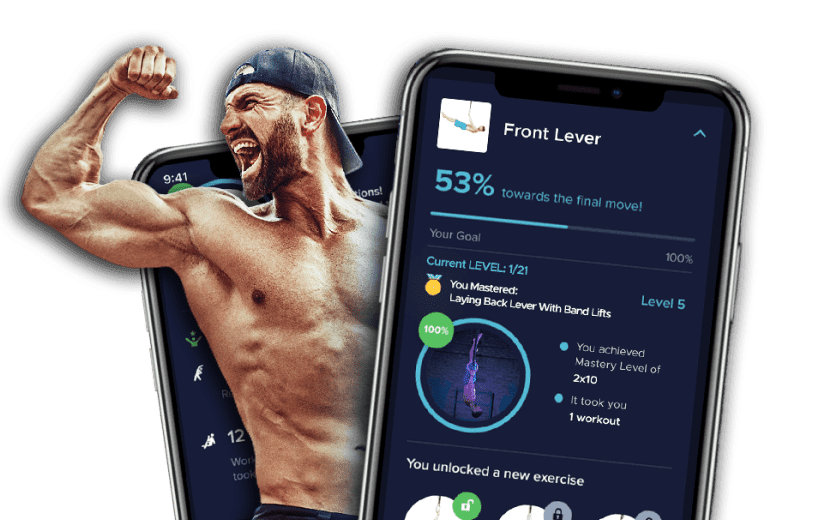
UNSURE HOW TO GET STARTED
Get a FREE personalized plan here
(No strings attached)